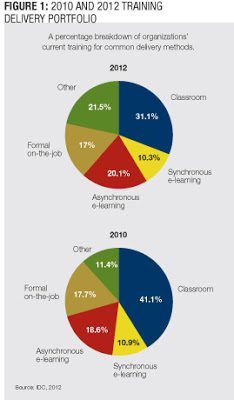Results from the 2012 Chief Learning Officer magazine Business Intelligence Board (BIB) learning delivery survey, administered by IDC, suggest organizations are getting more sophisticated in their modality choices. Asynchronous e-learning is increasingly seen as the preferred delivery method to train a group with varied skill levels. Classroom training remains the most significant form of training despite innovative alternatives.
Last year, a similar survey predicted asynchronous delivery modalities would grow in portfolio share and that classroom-based learning technology would decline in use. However, while CLOs report a shift in their emphasis away from classroom learning technology toward e-learning, the overall portfolio share hasn’t changed much. Learning delivery’s future includes more emphasis on social learning, increased use of mobile technologies and a continued refinement of how and when to use e-learning.
The Economy in the Driver’s Seat
CLOs are using a full range of options to deliver learning. Consistent with previous IDC surveys, research indicates classroom training is used most often, but the combination of synchronous and asynchronous e-learning continues to represent a growing modality.
Further, results show a big decline in the use of classroom-based training from 2010, a small increase in synchronous and asynchronous e-learning and a large gain in “other” (Figure 1). This suggests enterprises are bypassing traditional e-learning options and exploring other experiences such as performance support or peer-based training.

The research also indicated mobile devices are used a limited amount for training — about as often as video-based instruction — but their use is valuable in specific circumstances. On the other hand, a significant number of organizations are leveraging formal on-the-job training; its use hasn’t changed much in the past couple of years.
CLOs adjust their use of various modalities because of cost, convenience and effectiveness. Research indicates organizations that reduced their classroom-based information and learning technology (ILT) were most often driven by cost. Yet when organizations increased their use of classroom-based instruction, it was because of availability and effectiveness.
Cost and convenience drove the increased use of instructor-led — synchronous — e-learning. Convenience and availability drove the additional use of asynchronous e-learning. Formal, on-the-job training continues be effective in specific situations.
Further, for the fourth straight year, portable learning technologies did not gain as much share as expected. Even as the pervasiveness of smart mobile devices climbs, CLOs remain concerned about content availability and technology functionality.
Next year CLOs expect use of classroom-based ILT to continue to decline, primarily because of cost and flexibility. Both synchronous and asynchronous e-learning will gain portfolio share in most enterprises as a result of continued pressure on development budgets and greater flexibility in scheduling and delivery. Text-based training, while remaining a relatively modest proportion of most enterprise training programs, continues to be considered cost-effective and therefore useful to CLOs.
Interest in simulations is also increasing. While representing a modest share of the overall delivery portfolio, CLOs express great interest in seeing that share increase. CLOs also are interested in expanding use of smart mobile technologies in training delivery; however, this interest is not new. Further, instructional designers and content providers are becoming more sophisticated in their ability to design blended learning and benefit from blending their offerings for specific types of populations. In contrast to prior years, blended learning is less constrained by availability, and CLOs are building blended experiences to fit their requirements.
Match the Message to the Medium
One way the learning message can be defined is by content type: business skills courses or IT content (Figure 2). Preferences for delivery modality by content domain have changed little since 2007. A far greater majority of CLOs describe classroom-based ILT (C-ILT) as the primary delivery modality for business skills training — 59 percent — than describe C-ILT as primary for IT skills training — 38 percent — but the magnitude of the preference for C-ILT is declining overall.

Compliance training is the only learning content domain where C-ILT is not considered the primary delivery modality, with most enterprises preferring self-paced e-learning — 68 percent — to C-ILT — 16 percent. For new-hire training, the preference for C-ILT — 46 percent — is closely followed by self-paced e-learning — 17 percent — and instructor-led e-learning and on-the-job instruction, both at about 14 percent.
While not a delivery modality, discussion of informal learning always arises when delivery choices are considered. As previously noted, on-the-job training (OJT) experiences are a frequently used instruction method. Whether those OJT experiences are formal or informal is often a matter of semantics. In separate research on informal learning, nearly half of CLOs believe their organizations should do more to support informal learning. CLOs also believe that informal learning has the same impact as formal instruction. In spite of the recent and continued emphasis on social media to support learning, the most significant types of informal learning aren’t technology based. On-the-job experiences, mentoring, and discussions and networking with other professionals are traditional, low-tech forms of instruction and are considered among the most important types of informal learning.
Business skills courses largely focus on soft skills and, CLOs believe, lend themselves to face-to-face experiences with instructors and peers. It is clear that CLOs see the value of classroom instruction when it is appropriate for the content to be conveyed. E-learning, however, is consistently seen as a more appropriate method to deliver IT skills content.
Approximately 40 percent of the enterprises select at least one form of e-learning as the primary delivery method for IT skills training compared to only 26 percent who selected it as their primary modality for business skills training. In 2010, only 15 percent considered e-learning a primary delivery modality for business skills courses. Current instructional practices for IT skills tend to emphasize both independent study and practice over shared learning and group work.
At the same time, research and practice suggests teaching technology by using technology results in effective instruction more often than teaching non-technology content using technology. As collaborative technologies make their way into online instructional modalities, CLOs likely will observe increased value and use of collaborative e-learning experiences when teaching IT and business skills.
Modality, Skill and Seniority
In every organization, the training team has to account for a mix of skill levels among workers. Similar to responses from previous studies, text-based training and formal OJT are considered more effective with lower-skilled workers, and e-learning, both synchronous and asynchronous, is considered more effective for higher-skilled employees. Because asynchronous e-learning is consumed at the student’s pace, it is the preferred modality for higher-skilled employees and where scheduling the course or the students is a priority (Figure 3).

Portable technologies — smartphones, MP3 players and CD-ROM-based courses — are considered to have better results with higher-skilled employees, but experience has shown CLOs they are also effective with more junior-level employees.
While survey results imply different audience types react differently to different content types, specific combinations of content, audience and environment can make any delivery modality more appropriate. CLOs and training managers must consider the unique circumstances prompting a training intervention and determine the best combination of content and delivery.
As the U.S. economy continues to improve, the change in corporate training will slowly continue. CLOs will assess the strengths and weaknesses of different delivery modalities and leverage content that facilitates learner use.
Given economic priorities such as cost control and austerity, leveraging existing content across as many modalities as possible will be common as CLOs use what they have on the shelf. Over time, this suggests more training will be live-over-the-Web, synchronous e-learning, probably leveraging existing Web-conferencing technologies. Classroom training will remain the most significant mode of training, but CLOs are getting better at incorporating other delivery approaches — texts, self-paced work, action-learning — to make the classroom experience richer and ensure the content becomes part of the student’s working memory.
The Tides Ahead
Research indicates CLOs observe three shifts in delivery: Social, mobile and e-learning.
Social learning, in many forms, appears to be a way to adopt relevant, cost-effective training while the enterprise still maintains a semi-active role in development and leveraging more traditional values as self-directed learning. One CLO who responded to the survey said: “I see a movement towards self/intentional learning in a blended environment. Train early and reinforce often.” Another CLO reflected a more radical change in the relationship between student and instructor: “In the next 12 to 18 months delivery will move to a more asynchronous environment with trainers serving as moderators of the social learning.”
Mobile learning, while not strongly reflected in the current paradigm, appears as an opportunity to many CLOs. “As mobile device functionality increases, more training can be at the user’s fingertips. Users will be able to choose the time best for them to view the training,” predicts one CLO. Another sees a more moderate pace: “I see greater usage of device-based training, but ILT and e-learning will still be the primary methods of delivery [because the] infrastructure is already established. … Device-based learning is great as a reference for information already taught, but we don’t see it as a delivery method to teach new skills.”
Finally, e-learning in many forms continues to represent an opportunity for CLOs. One CLO reflects the views of many that “technology and innovation will align better to learning needs and business infrastructure. As this evolves more learning will become available through technology such as video and electronic performance support.” Another represents the view that the future is here, but not fully distributed: “We will continue moving towards a blended e-learning style.”
Cushing Anderson is program director for learning services at IDC, a market intelligence firm. He can be reached at editor@CLOmedia.com.















